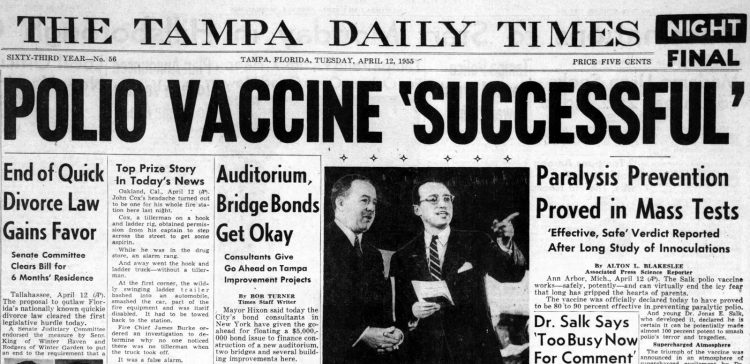1955 – Pittsburg, Pennsylvania: Some diseases killed, polio crippled children for a lifetime. Since the first epidemic in the summer of 1894 in Vermont, polio had become the disease most feared by parents. It struck children without warning, frequently causing muscle deterioration and paralysis, leaving many on crutches or in wheelchairs for the rest of their life. Research labs across America searched for a cure.
Jonas Salk, the son of Russian-Jewish immigrants, was born in 1914 in New York City. The first member of his family to attend college, at age 20 he graduated from City College of New York with a degree in chemistry. After being turned down by Harvard, Yale and Princeton medical schools – they had reached their quota of Jewish students – he chose New York University Medical School and graduated in 1939.
Salk chose to pursue medical research rather than become a practicing physician. Following a three-year-stint in research at New York’s Mount Sinai Hospital, he transferred to the University of Michigan to do research on influenza viruses. In 1947, concerned about polio epidemics, Salk joined a national team working on eradicating the virus. That same year he became director of the Virus Research Lab at the University of Pittsburg responsible for identifying the various strains of polio and finding a cure.
Polio had baffled medical researchers for six decades. It took years to determine the virus was found in fecal-contaminated water and transmitted orally. After World War II, summertime epidemics affecting children caused widespread panic among parents.
By 1950, Salk’s small laboratory had identified 125 different polioviruses. Because of his success, rather than fund some of the better-known and better-equipped laboratories in the country, the National Foundation for Infantile Paralysis chose to fund Salk’s vaccine research. Although the leading research teams worked with live polioviruses to develop a vaccine, Salk pursued a different method that utilized a “killed virus.” He was convinced that his approach could lead to a quicker cure.
Because of Salk’s unorthodox approach, several top virologists publically ridiculed his work. Albert Sabin, a leading researcher at Cincinnati Children’s Hospital at the University of Cincinnati, himself working on a “live-virus” vaccine, called Salk’s method dangerous. “You can do what he does in the kitchen,” said Sabin. “He is a mere kitchen chemist.”
Despite the stinging criticism, Salk worked tirelessly to find a cure. In March 1952, after testing his vaccine on several hundred monkeys, he believed that he had discovered an effective vaccine. Because of the concern and skepticism about his methodology, he decided to first test the vaccine on himself and his family members. Salk inoculated himself, his wife and three sons after boiling the needles and syringes on the kitchen stove. Just as he had anticipated, blood tests showed an increase in poliovirus antibodies and an effective vaccine.
Salk’s next step was to inoculate school children in Pittsburg, and there was no shortage of parents who wanted their children tested. Over the next two years, 1.8 million people, including 800,000 children, became polio vaccine volunteers making the health experiment the largest in U.S. history.
On April 12, 1955, the headlines of the major U.S. newspapers reported what Americans had long hoped for, “Polio is conquered!” After eight years of tests and trials, the 40-year-old Salk’s vaccine was at last deemed safe and effective.
The Kitchen Chemist had tried more than 200 unsuccessful vaccines before he finally found one that worked. When a reporter asked Dr. Salk how it felt to fail 200 times, he responded, “I was taught never to use the word failure. I never failed 200 times. I just discovered 200 ways how not to vaccinate for polio.”
“Hope lies in dreams, in imagination and in courage to those who dare to make dreams into reality.” Jonas Salk

Fantastic story. We need him now as much as we did then.
Since I am a lot older than you, I can testify that my mother and the mothers in our neighborhood were all concerned about polio. We could not drink ice cold water as it was thought to be a cause of polio.
I also remember eating the sugar cube that would vaccinate us against the disease. We ate three cubes over a period of time that I do not remember. My mother and other mothers all said a sigh of relief that their child would not get the dreaded disease!!!
Wonderful story !!!